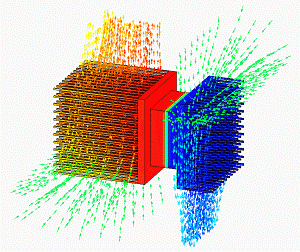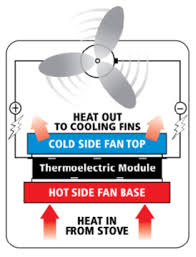Peltier-Seebeck Effect
Eco-fans generate their own electricity by utilizing heat from the stove. The fan acts as a thermal heat sink and absorbs heat through the broad base plate. A Peltier cooler is the brains of the device, taking advantage of the Peltier-Seebeck affect."The Seebeck effect is the conversion of temperature differences directly into electricity and is named after the Baltic German physicist Thomas Johann Seebeck. Seebeck, in 1821, discovered that a compass needle would be deflected by a closed loop formed by two different metals joined in two places, with a temperature difference between the junctions. This was because the metals responded to the temperature difference in different ways, creating a current loop and a magnetic field" .

Free convection thermoelectric cooler (Peltier cooler) with heat
sink surface temperature contours, and rising warmer air and
falling cooler air flow trajectories.
http://en.wikipedia.org/wiki/Thermoelectric_cooling
"In 1834 Jean Peltier took this discovery further by observing that two different metals or semiconductors that are connected in a particular way (Peltier junctions) could act as a heat pump if electricity was passed cross them. In other words heat would be pumped from one side to the other, creating one cool side and one hot side. Peltier coolers are often called thermo-electric coolers (TEC)". More simply, the Peltier cooler in the Eco-fan utilizes the movement of heated electrons caused by a temperature differential to provide low voltage electricity to the small electric motor.

http://www.environmentalliving.com.au/thumbnaillarge/Diagram-1.gif